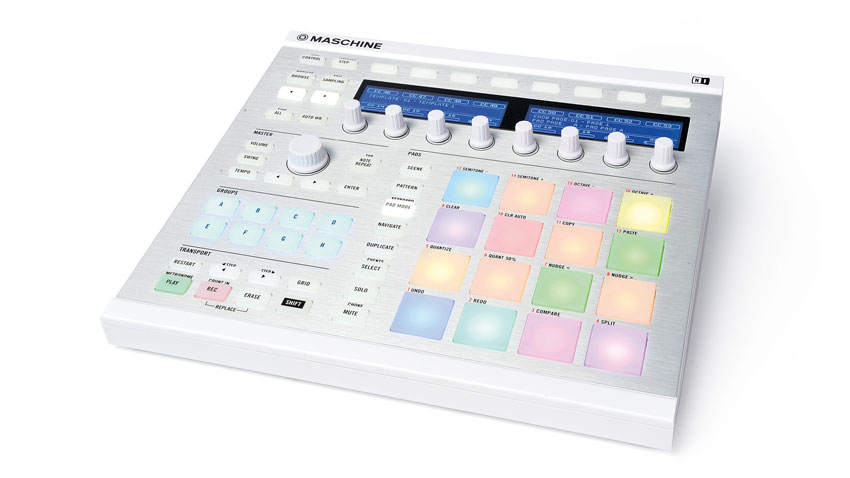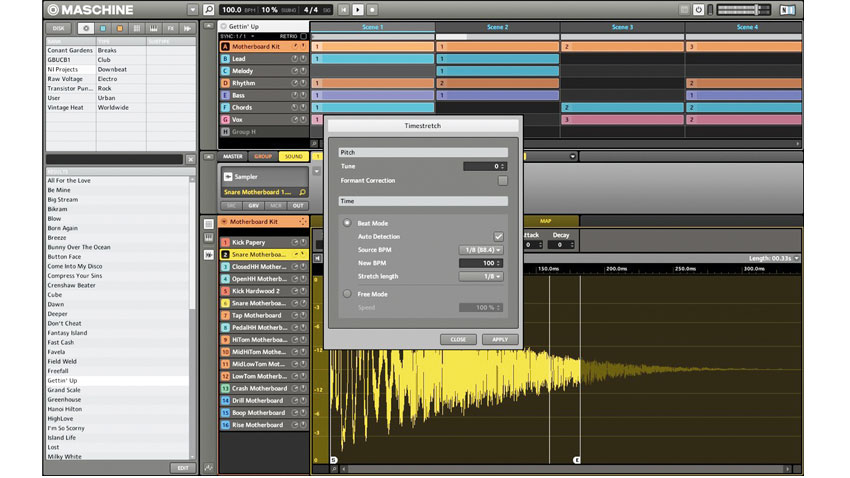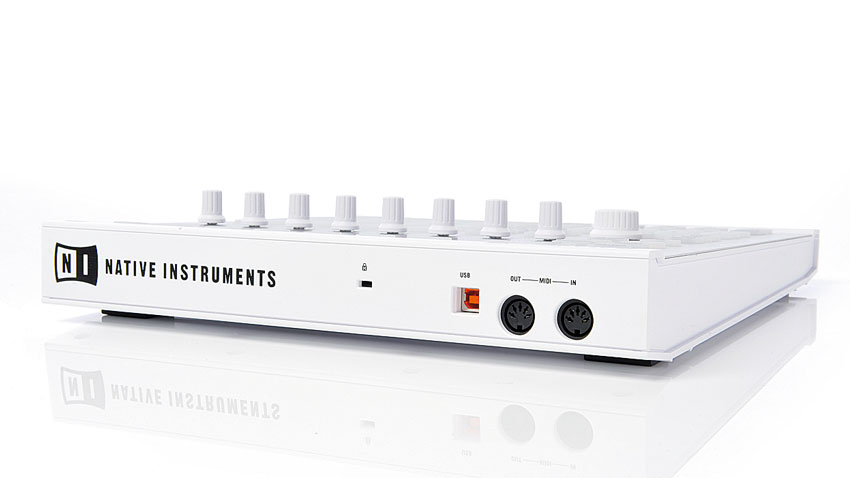MusicRadar Verdict
A colourful and worthy upgrade to the original Maschine, but not a 'must buy' for existing users.
Pros
- +
RGB pads are brilliant. Offline timestretching. Massive included!
Cons
- -
Lacks a few pitchshifting/timestretching features.
MusicRadar's got your back

Native Instruments Maschine mkII

Native Instruments Maschine mkII (software)

Native Instruments Maschine mkII (rear)
Native Instruments' Maschine has found favour with finger drummers and beat makers the world over since its release in 2009. Comprising a self-contained software production environment (running standalone or as a plug-in), a dedicated hardware controller with 16 MPC-style pads, and a fully browse-able 6GB library of sampled instruments, patterns, loops and hits, it's essentially a full-on DAW for pattern/groove-based projects.
"Enter Maschine mkII, a seemingly major revision to the pad-tastic box we know and love"
One of the package's main selling points is the integration between the controller and the software, which is so tight that pretty much every function of the software can be operated directly from the hardware. It's possible to work up complete projects or perform live on the Maschine controller without touching the host computer's mouse or even looking at its screen.
Over the last three years, the software has been updated many times, watershed improvements including drag-and-drop of MIDI and audio from Maschine into a host DAW, and VST/AU plug-in hosting. But, apart from some minor tweaks, the hardware remained alone and unchanged until the release of Maschine Mikro last year. A cut-down alternative to the full enchilada, Mikro was a triumph of reductive ergonomics but it didn't actually add anything new to the Maschine concept.
Enter Maschine mkII, a seemingly major revision to the pad-tastic box we know and love, arriving at roughly the same time as (and only supported by) version 1.8 of the software.
The hardware
"The RGB backlist pads look awesome and take that famously fast Maschine workflow to a whole new level"
The most apparent change to Maschine mkII is the new RGB backlit pads and buttons. Maschine 1's blue buttons and orange pads were (and, indeed, still are) pretty sexy, but mkII's multicoloured pads and Group buttons are something else altogether. They look awesome and really do take that famously fast Maschine workflow to a whole new level.
Every group and every sound within each group can be set to one of 16 colours in the Maschine software, with assignments mirrored in the hardware. Set your main drum kit group to red, say, your bass instrument group to blue and your pads to green for at-a-glance identification of your general instrumentation; then colourise the sounds/pads inside each group - kick drums blue, snares red, hi-hats green, etc.
"Colours can also be assigned to individual patterns and scenes, which makes jumping around within projects intuitive"
Colours can also be assigned to individual patterns and scenes, which makes jumping around within projects similarly intuitive. Also on a visual tip, the dual backlit screens are now 'inverted' - i.e., white text and waveforms on a black background - making them clearer in low light and just better looking generally.
In terms of physical layout, the new hardware is identical to the old, with the exception of the Master section, which has been totally redesigned. On the original Maschine, this comprised Volume, Tempo and Swing knobs, and the Note Repeat button; now there's just the one detented push-button encoder and buttons to switch it between Volume, Tempo and Swing modes, as well as single step buttons (the equivalent of one encoder detent left or right), an Enter button (the equivalent of pressing the encoder), and the aforementioned Note Repeat button.
It's the added functionality of the encoder that pushes things forwards, though: with the Volume, Swing and Tempo buttons all inactive, it acts like a jogwheel, replicating the Transport section's Step buttons. And, with Maschine Mk2 in Browse mode, it can be used to scroll through menus and make selections. This all certainly enhances Maschine's workflow, but MIDI Control mode fans might be a little dismayed at the loss of two knobs.
Other than that (and the top Transport buttons now being slightly narrower), all the buttons are in the same places on the fascia and serve the same purposes they always have. But the feel of the buttons has changed: they now have a satisfying click rather than the unresponsive 'squish' of old.
Maschine's pads have always been supremely playable, and Maschine mkII is even more so. With the velocity sensitivity cranked up, even the lightest of touches are effective, yet there's never any crosstalk or double triggering - it plays beautifully.
Finally, on the hardware front, the previously confused USB and MIDI ports have been grouped and moved over to the left side of the backplate.
The software
The Maschine 1.8 software is a free update for existing Maschine users and is exactly the same no matter which generation or size of controller you use with it - and that includes the new colour-coding system, although obviously the mkI hardware doesn't reflect it.
"The headline feature for many will be the bundling of NI's legendary Massive synth with the update"
The headline feature for many will be the bundling of NI's legendary Massive synth with the update - a pretty amazing freebie, and surely a sign that Massive 2 is on the way.
After that, it's the independent offline timestretching and pitchshifting that's going to be most enthusiastically received. These are applied to the selected region via an overlaid dialog box that can be edited onscreen or via the hardware, and it works very well indeed. Maschine auto detects the tempo of the original audio, thus enabling it to be stretched to a specific tempo, number of bars or subdivision of one bar, as well as by a percentage. Stretching by bar/division is the niftiest option, enabling incredibly quick setup of synced loops and easy adjustment of sliced samples to fit the project tempo.
Audio Example 1: Timestretching and pitchshifting
The pitchshifting section, meanwhile, includes optional Formant Correction and three octaves of adjustment either way. What Maschine still can't do, however, is automatically map a single sample across all 16 pads and pitchshift each instance without also timestretching it (or timestretch without pitchshifting, although that wouldn't be so useful) to make an unstretched multisampled instrument.
Anyhow, although it's 'offline', Maschine's timestretching is fully operable via the controller, quick, creatively integrated and sonically excellent. It would still be good to see some sort of 'elastic audio' engine introduced, though, for real-time, knob-driven stretching.
"Maschine now has a scrolling playhead in the sample display, which makes a significant difference to audio manipulation"
While we're on the subject of the sample editor, Maschine now has a scrolling playhead in the sample display. The positive difference that this makes to audio manipulation using the controller screens is significant. Making event selections in Select mode is now done by dialling in a time range rather than specifying a number of contiguous notes.
The only onscreen indication of the selection range is still the highlighting of notes within it, rather than any sort of discrete markers, but it is a more logical system than before. More importantly, when Select mode is active (and it can now be pinned, incidentally), knobs 5-8 now enable quick adjustment of note position, length, pitch and velocity - superb.
Audio Example 2: Saturator Tape
Other new features include Auto Write, which can now be pinned, so you can use both hands to write automation, rather than having to hold down the Auto Write button with one. The transport section now controls playback of the host DAW in plug-in mode (at the expense of the Erase button, which becomes the Stop button). Quick Select and Quick Erase shortcuts enable selection and deletion of all events on a given pad.
Auditioning within the browser can be turned on and off from the controller. Groups can be saved with their contained samples, and missing samples in projects are now handled more sensibly. Multiple instances of Maschine can be controlled by separate controllers, and multiple controllers can be switched between control of one instance of Maschine. There are also some tasty new effects, too, including Transient Master (taken directly from Guitar Rig) and new Tube and Tape modes for the Saturator module.
Audio Example 3: Transient Master Sustain
If money were no object…
The new Maschine software is moving things steadily forward towards the inevitable version 2.0, and there are going to be things you 'need' that still haven't been added or fixed. You still can't loop sections within patterns, there's still no multicore support and it still sends the same MIDI data on all four ports, to name but three of my personal peeves.
"You'd be hard pushed to argue that this isn't the best version yet"
Nonetheless, you'd be hard pushed to argue that this isn't the best version yet - the offline timestretching and new Select mode functionality alone make it a winner. And, of course, being free to all Maschine owners and including Massive, it's a no-brainer.
As for the new controller, that's not quite so straightforward. If you're already a Maschine user with a bit of cash to splash, you've got a bit of a tricky decision to make. The colour coding certainly qualifies Maschine mkII as a significant upgrade over mkI but it won't make any difference to the quality of your output - you'll still be using the same software in the same way as you would if you stuck with what you've already got, just without the helpful colour-coding.
However, that colour-coding really is very cool, as is the new Master section and the inverted displays… Like I said, a tricky decision. Newcomers, though should just go and get it.
A music and technology journalist of over 30 years professional experience, Ronan Macdonald began his career on UK drummer’s bible, Rhythm, before moving to the world’s leading music software magazine, Computer Music, of which he was editor for over a decade. He’s also written for many other titles, including Future Music, Guitarist, The Mix, Hip-Hop Connection and Mac Format; written and edited several books, including the first edition of Billboard’s Home Recording Handbook and Mixing For Computer Musicians; and worked as an editorial consultant and media producer for a broad range of music technology companies.
“It is ingrained with my artwork, an art piece that I had done years ago called Sunburst”: Serj Tankian and the Gibson Custom Shop team up for limited edition signature Foundations Les Paul Modern
“Even my cat is disappointed in me”: Deadmau5 gets drunk at Coachella, falls over, is escorted off stage by security, and apologises
“The last thing Billy and I wanted to do was retread and say, ‘Hey, let’s do another Rebel Yell.’ We’ve already done that”: Guitar hero Steve Stevens lifts the lid on the new Billy Idol album










